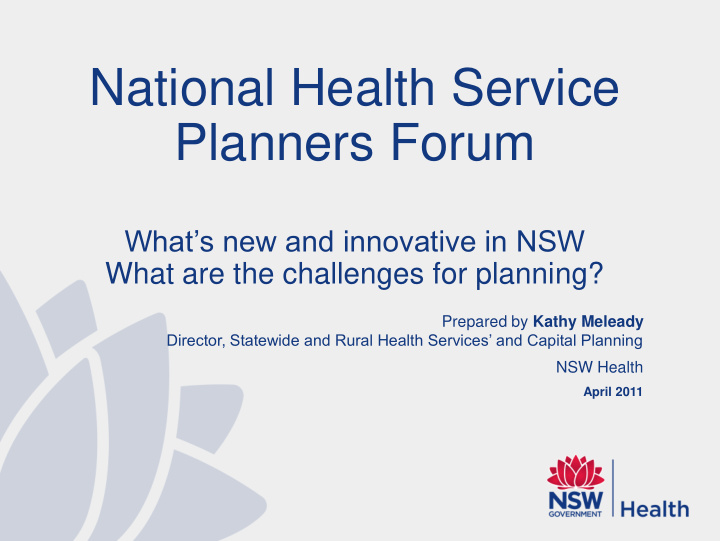



National Health Service Planners Forum What’s new and innovative in NSW What are the challenges for planning? Prepared by Kathy Meleady Director, Statewide and Rural Health Services’ and Capital Planning NSW Health April 2011
Metropolitan and Outer Urban Local Health Networks
Rural and Regional Local Health Networks
Statewide and Specialty Service Planning Statewide Plans: These plans focus across the state population as a whole, to plan and develop super specialist services (high cost/high complex/low volume) in the most accessible, sustainable and effective manner. Radiotherapy Services in NSW to 2016 Super Speciality Plans - NSW Trauma Services (2009), Acute Spinal Cord Injury (2010), Bone Marrow Transplantation (2010). Service Planning Series
Service Development Planning Guidelines Guides for specific service planning: – Subacute Inpatient Services (2006) – Intravenous Chemotherapy Services (2007) – Service Guidelines for Operating Theatres (2007) – Maternity Services Inpatient Capacity and Projection Methods (2008) – Principles for Emergency Care Models in NSW Small Rural Hospitals (2010) – Factors that Impact the Referral Rates for Radiotherapy (2011)
Planning Tools Technical planning tools: – FlowInfo – aIM – acute inpatient modelling – SiAM – subacute inpatient activity modelling – Operating Room Modelling – MHCCP – Mental Health – Clinical Care & Prevention model
FlowInfo FlowInfo is a PC based inpatient service-planning tool used by NSW Health and the Local Health Networks (LHN). Inpatient activity can be analysed by any combination of variables including: – age, sex, – local government area of residence, – hospital of treatment, AHS of residence, AHS of treatment, month of treatment, – ANDRG and SRG.
FlowInfo - output Activity is reported in: – separations, – beddays and – cost weighted separations. FlowInfo is updated regularly and data is currently provided for 1997/98 to 2008/09.
FlowInfo - advantages The major advantage is that – it is user-friendly, allowing users who do not have statistical or programming expertise to undertake complex analysis of inpatient data; and – it has the ability to apply standard definitions to information elements on a system-wide basis. Contains data on admitted patients treated in: Public and Private NSW facilities Public Interstate facilities
Inpatient Activity Projection Tools – aIM Projection modelling tools have been used in NSW since the 1990s Are developed and regularly reviewed to incorporate: – New projections of population growth and ageing – Changing epidemiology – Clinical practice changes/emerging models of care aIM is a medium to long term projection tool that allows users to model future demand for acute inpatient care
What does the aIM do? aIM uses historical trends (10 years) of hospital utilisation (admission rates and length of stay) and projected population growth to project future utilisation Projections are by age group, sex, Enhanced Service Related Group (ESRG) and Local Government Area (LGA) Assumptions are made about urgent/non-urgent, public/private mix and other factors
SiAM – Sub acute inpatient activity Modelling Approach A supplement to the aIM 2010 tool is the Sub Acute Inpatient Activity Model (SiAM). SiAM 2010 is also an interactive PC based planning tool which provides a best estimate of the future demand of sub acute services. There is also a data book summarising these projections at a SiAM clinical category level.
SiAM – Sub acute inpatient activity Modelling Sub-acute activity broken down into 5 broad categories Rehabilitation Palliative care Geriatric Evaluation & Management Psychogeriatrics (older persons mental health) Maintenance Care
Principles for Emergency Care Models in Small Rural Hospitals Planning Guideline released in August 2010 Targeted at ‘emergency departments’ NSW role delineation level of 1 or 2 Set of principles to be considered developing alternate models for planned and unplanned emergency presentations
Surgery Futures Literature review, activity analyses, clinical consultation Guidance on optimal configuration of surgical centres Basis to inform service and capital planning 2 elements – Metropolitan – Rural
NSW Telehealth There are over 600 telehealth units in NSW delivering a range of education and specialist clinical support including:- Connecting Critical Care Telehealth Paediatric Oncology – Westmead Hospital Child and Adolescent Psychiatric Telehealth Outreach Service (CAPTOS) Diabetes Foot Clinic – Royal Prince Alfred Hospital Mental Health Emergency Care Rural Access Program – Greater Western LHN http://internal.health.nsw.gov.au/telehealth/index.html
Complex Epilepsy Complex and somewhat chronic patient cohort Small poorly understood super speciality services Significant workforce issues Each unit provided system expertise in various aspects of assessment/management ie VNS, PET scanning and DBS Limited technological capacity
Complex Epilepsy Formalised Statewide network established = legitimisation for clinicians & trusting relationship with Department Workforce and equipment supplementation = enhanced capacity and succession planning Technology improvements = greater clinical collaboration and cross referral for individual expertise Agreed MDS = quality improvements and clinical benchmarking
Connecting Critical Care (CCC ) What is it?.... The Metropolitan and Regional Connecting Critical Care Research Application incorporated: 1 Coordinating Hub: Aeromedical and Medical Retrieval Service (AMRS) 2 Receiving Facilities (Hubs): RPAH and RNSH 5 Referral Facilities (Spokes): Orange, Bathurst, Dubbo, Tamworth and Moree. Education an integral component of the project.
Challenges and Responses. Introduction of New Technology Nationally Funded Centres Program Level of evidence there is to support investment Higher level of technical specifications Does investment result in improved clinical outcomes? The rapid pace in development of some of these technologies and the specialised nature of the upgrades makes it difficult for informed and/or evidence based decision making
Challenges and Responses. New Technology Developments Diagnostic and therapeutic equipment: - Multi slice CTs - PET - MRI - Angio suites - Linacs - Special imaging suites - Hybrid technologies such as PET/MRI and intraoperative MRI New technologies with implications for capital planning
Recommend
More recommend